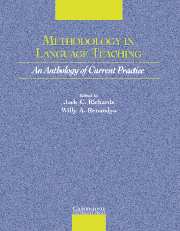Book contents
- Frontmatter
- Contents
- Acknowledgments
- Introduction
- Section I Approaches to Teaching
- Section 2 Lesson Planning and Classroom Management
- Section 3 Classroom Dynamics
- Section 4 Syllabus Design and Instructional Materials
- Section 5 Task and Project Work
- Section 6 Learning Strategies
- Section 7 Teaching Grammar
- Section 8 Teaching Pronunciation
- Section 9 Teaching Speaking
- Section 10 Teaching Listening
- Section 11 Teaching Vocabulary
- Section 12 Teaching Reading
- Section 13 Teaching Writing
- Section 14 Assessment
- Section 15 Technologies in the Classroom
- Chapter 36 Video in the ELT Classroom: The Role of the Teacher
- Chapter 37 The Internet for English Teaching: Guidelines for Teachers
- Chapter 38 What Can the World Wide Web Offer ESL Teachers?
- Section 16 Professional Development
- Credits
- Author Index
- Subject Index
- References
Chapter 37 - The Internet for English Teaching: Guidelines for Teachers
Published online by Cambridge University Press: 10 November 2010
- Frontmatter
- Contents
- Acknowledgments
- Introduction
- Section I Approaches to Teaching
- Section 2 Lesson Planning and Classroom Management
- Section 3 Classroom Dynamics
- Section 4 Syllabus Design and Instructional Materials
- Section 5 Task and Project Work
- Section 6 Learning Strategies
- Section 7 Teaching Grammar
- Section 8 Teaching Pronunciation
- Section 9 Teaching Speaking
- Section 10 Teaching Listening
- Section 11 Teaching Vocabulary
- Section 12 Teaching Reading
- Section 13 Teaching Writing
- Section 14 Assessment
- Section 15 Technologies in the Classroom
- Chapter 36 Video in the ELT Classroom: The Role of the Teacher
- Chapter 37 The Internet for English Teaching: Guidelines for Teachers
- Chapter 38 What Can the World Wide Web Offer ESL Teachers?
- Section 16 Professional Development
- Credits
- Author Index
- Subject Index
- References
Summary
Teachers have been using online communication in the language classroom since the 1980s. From an investigation of the experiences of dozens of teachers around the world who have used the Internet in language teaching (Warschauer, 1995a, 1995b, 1996c, 1996d), a few common guidelines emerge that can assist teachers in successfully planning and implementing network-based learning projects.
GUIDELINES
Readers will note that these guidelines are independent of the particular technological tools being used. As has been noted elsewhere, “technology is developing so rapidly that it can often be difficult or even overwhelming to harness somewhat like trying to get a drink of water from a gushing fire hydrant” (Warschauer, 1995b, p. xv). In order to make effective use of new technologies, teachers must thus take a step back and focus on some basic pedagogical requirements. The following guidelines are designed to help teachers implement computer network-based activities and technologies into the second language classroom.
CONSIDER CAREFULLY YOUR GOALS
There are several possible reasons for using the Internet in language teaching. One rationale is found in the belief that the linguistic nature of online communication is desirable for promoting language learning. It has been found, for example, that electronic discourse tends to be more lexically and syntactically complex than oral discourse (Warschauer, 1996a) and features a broad range of linguistic functions beneficial for language learning (Chun, 1994; Kern, 1995; Wang, 1993).
- Type
- Chapter
- Information
- Methodology in Language TeachingAn Anthology of Current Practice, pp. 368 - 373Publisher: Cambridge University PressPrint publication year: 2002
References
- 9
- Cited by



